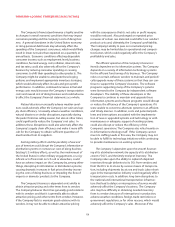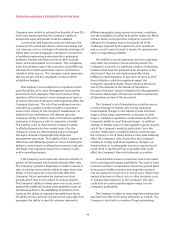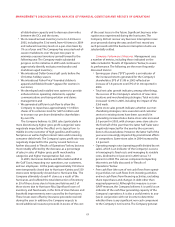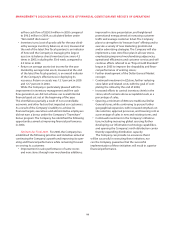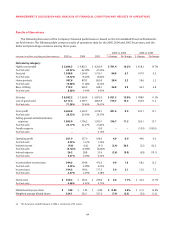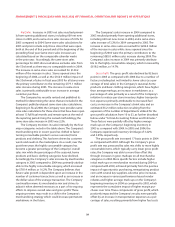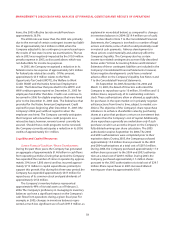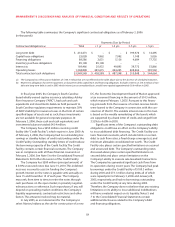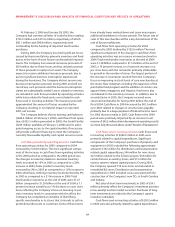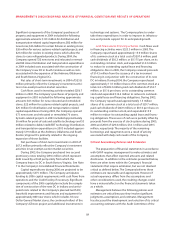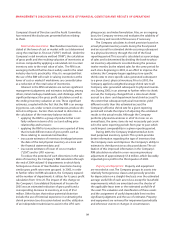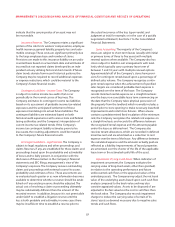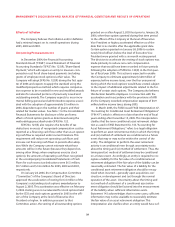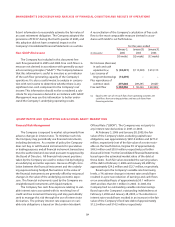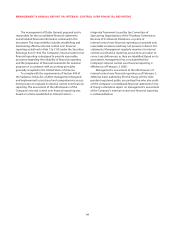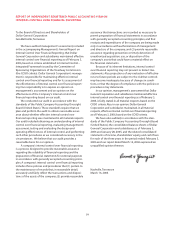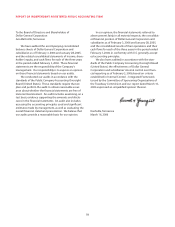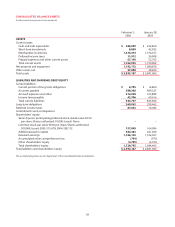Dollar General 2005 Annual Report Download - page 27
Download and view the complete annual report
Please find page 27 of the 2005 Dollar General annual report below. You can navigate through the pages in the report by either clicking on the pages listed below, or by using the keyword search tool below to find specific information within the annual report.
23
MANAGEMENT’S DISCUSSION AND ANALYSIS OF FINANCIAL CONDITION AND RESULTS OF OPERATIONS
In fiscal year 2005, the Company’s South Carolina-
based wholly owned captive insurance subsidiary, Ashley
River Insurance Company (“ARIC”), had cash and cash
equivalents and investments balances held pursuant to
South Carolina regulatory requirements to maintain 30%
of ARIC’s liability for insurance losses in the form of certain
specified types of assets and as such, these investments
are not available for general corporate purposes. At
February 3, 2006, these cash and cash equivalents and
investments balances totaled $43.4 million.
The Company has a $250 million revolving credit
facility (the “Credit Facility”), which expires in June 2009. As
of February 3, 2006, the Company had no outstanding bor-
rowings or standby letters of credit outstanding under the
Credit Facility. Outstanding standby letters of credit reduce
the borrowing capacity of the Credit Facility.The Credit
Facility contains certain financial covenants.The Company
was in compliance with all these financial covenants at
February 3, 2006. See Note 5 to the Consolidated Financial
Statements for further discussion of the Credit Facility.
The Company has $200 million (principal amount) of
8 5/8% unsecured notes due June 15, 2010. This indebted-
ness was incurred to assist in funding the Company’s
growth. Interest on the notes is payable semi-annually on
June 15 and December 15 of each year. The Company
may seek, from time to time, to retire the notes through
cash purchases on the open market, in privately negotiat-
ed transactions or otherwise. Such repurchases, if any, will
depend on prevailing market conditions, the Company’s
liquidity requirements, contractual restrictions and other
factors.The amounts involved may be material.
In July 2005, as an inducement for the Company to
select Marion, Indiana as the site for construction of a new
DC, the Economic Development Board of Marion approved
a tax increment financing in the amount of $14.5 million,
which matures February 1, 2035. Pursuant to this financ-
ing, proceeds from the issuance of certain revenue bonds
were loaned to the Company in connection with the con-
struction of this DC. The variable interest rate on this loan
is based on the weekly remarketing of the bonds, which
are supported by a bank letter of credit, and ranged from
3.52% to 4.60% in 2005.
Significant terms of the Company’s outstanding debt
obligations could have an effect on the Company’s ability
to incur additional debt financing. The Credit Facility con-
tains financial covenants, which include limits on certain
debt to cash flow ratios, a fixed charge coverage test, and
minimum allowable consolidated net worth. The Credit
Facility also places certain specified limitations on secured
and unsecured debt. The Company’s outstanding notes
discussed above place certain specified limitations on
secured debt and place certain limitations on the
Company’s ability to execute sale-leaseback transactions.
The Company has generated significant cash flows from
its operations during recent years. The Company had peak
borrowings under the Credit Facility of $100.3 million
during 2005 and $73.1 million during 2004, all of which
were repaid prior to February 3, 2006 and January 28,
2005, respectively, and had no borrowings outstanding
under the Credit Facility at any time during 2003.
Therefore, the Company does not believe that any existing
limitations on its ability to incur additional indebtedness
will have a material impact on its liquidity. Notes 5 and
7 to the Consolidated Financial Statements contain
additional disclosures related to the Company’s debt
and financing obligations.
The following table summarizes the Company’s significant contractual obligations as of February 3, 2006
(in thousands):
Payments Due by Period
Contractual obligations(a) Total < 1 yr 1-3 yrs 3-5 yrs > 5 yrs
Long-term debt $ 214,473 $ – $ – $ 199,978 $ 14,495
Capital lease obligations 22,028 7,862 7,992 1,148 5,026
Financing obligations 89,586 2,031 5,136 4,684 77,735
Inventory purchase obligations 85,148 85,148 – – –
Interest (b) 169,466 25,933 49,895 39,772 53,866
Operating leases 1,368,848 281,615 424,225 269,466 393,542
Total contractual cash obligations $1,949,549 $ 402,589 $ 487,248 $ 515,048 $ 544,664
(a) The Company has self-insurance liabilities of $154.7 million that are not reflected in the table above due to the absence of scheduled maturities.
(b) Represents obligations for interest payments on long-term debt, capital lease and financing obligations. Excludes interest on $14.5 million of vari-
able rate long-term debt issued in 2005 which interest, on an annualized basis, would have equaled approximately $0.6 million in 2005.


